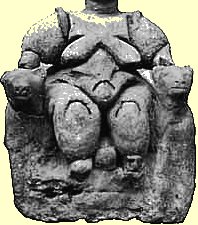Plaster in Çatalhöyük
Today, the surprising cement that held an ancient city together. The University of Houston's College of Engineering presents this series about the machines that make our civilization run, and the people whose ingenuity created them.
The city of Çatalhöyük once thrived in southern Turkey, not far from the later city of Antioch. Five, maybe ten, thousand people lived there, nine thousand years ago. It's the oldest known city of such size. Here we discover a rich texture of daily Neolithic life just after the invention of agriculture.
The site was discovered in 1958. Excavations began three years later, only to be halted when the Turkish government found artifacts turning up outside of Turkey. They let excavations begin again in 1993, and a great deal has been done since then.
Çatalhöyük thrived four thousand years before the wheel, before metals, before writing. This was the very beginning of that part of the Stone Age that we call the Neolithic Era.
It was both a great city and a puzzling one as well. This is hot, arid country today, but it was different back then. In those days, Çatalhöyük sat upon two mounds that looked out over a watery marshland. Now we learn that the farmland where the people grew their grains, and the forests where they cut their oak and juniper wood, were twelve or so miles from the city.
How was it practical to move goods that far without the wheel? They probably used a system of boats to do it. Çatalhöyük clearly represented complex organization and commerce. Since no remains have turned up in the farming regions, her citizens must've merely camped out during planting and harvesting seasons.
The best-known yield of the dig is its art. We find many examples of the so-called Goddess Image. Such images were rendered in stone, bone, and clay throughout the pre-agricultural era and in many places. She was shown as obese, with exaggerated female characteristics. It's probably a stretch to say that she represents monotheistic goddess worship and a matriarchal society. Here in Çatalhöyük we also find images of stags, of men hunting -- all the suggestions of an energetic and balanced society at work.
The people of Çatalhöyük made finely polished obsidian mirrors. They had an early cottage textile industry. They created elaborate burial sites. They used portable ladders to enter their uniform mud-brick houses through openings in the roofs. They managed their trash. They had a complex urban organization long before we would've expected it.
An article in Science Magazine makes a startling suggestion as to where this social cohesion came from. The soil just under the marshes surrounding Çatalhöyük was rich with a chalky marl. It may be mixed into a clay-like mud, which we could call plaster. Plaster made its houses. Wall frescos were painted upon plaster. The people of Çatalhöyük appear to've been drawn to the artistic and technical possibilities of a new building material.
What an unnerving idea, that the binding social fabric of this remarkable early city should be nothing more grand than -- plaster.
I'm John Lienhard, at the University of Houston, where we're interested in the way inventive minds work.
(Theme music)
Balter, M. Did Plaster Hold Neolithic Society Together? Science, Vol. 294 14 Dec., 2001, pp. 2278-2281.
Meskell, L. Twin Peaks: The Archaeologies of Çatalhöyük. Ancient Goddesses: The Myths and the Evidence, Madison WI: University of Wisconsin Press. Chapter 2.
See also, the Wikipedia page about Çatalhöyük.

Most famous of the many Çatalhöyük "Goddess" images.